

|
Back to |
| The Front Page |
| Letters & Opinion |
|
My romance with photography by Bob Chilton posted December 24, 2016
|
Bob Chilton is well known as both a competitor and a photographer in the croquet world, especially in America, where his photographs have often appeared in both online and on-paper publications. He has published two books of photography, he's working on a croquet video, and his website is a treasure-trove of striking images ranging across many of the personal interests cultivated as reward for a long and successful career as investor and chief executive of an information technology company in Texas: sailing, fishing, riding, traveling the world. Much of what he saw he wanted to record; but often he'd rather reveal more than his camera actually recorded, sharing the view from his mind's eye. While many photographers eschew the "magic" of PhotoShop, Chilton embraces the tools it gives him to more fully communicate his own experience and insight as an artist with a digital camera.
It began decades ago in the film and darkroom era, as informal study with a co-op of amateurs learning the basics of the craft. Those first adventures with a camera--underwater in diving gear--produced stunningly colorful images. The sights and colors in those photographs brought forth the first "wows" I earned as an artist.
As CEO of a publicly traded company in Texas in the 90's, I had no more precious commodity than time. So the advent of digital processing photography was a major event in my life. Images that would have required hours of editing in a darkroom could now be produced much more quickly, and with greater quality and creativity.
While digitally capturing an image was a major breakthrough, it's the critically important post-process editing that creates the final piece, the vehicle for expressing a photographer's artful intent. In that processing, the photographer aims to engage the viewer's imagination and elicit his emotion. Here he becomes the artist, in fact, painting with his computer "mouse" meticulously crafted final touches that transform a mere photographic record into something more, something uniquely eye-catching.
Travels in foreign lands brought another dimension and countless vistas before my camera. But regardless of the place or time of day, or even the subject, the art of the image always begins with visualizing a well-conceived composition, then getting a correct exposure, and completing the picture with an edit that combines and balances technical expertise with artistic sensibility.
All of that "work" constitutes a platform for achieving my personal mission as a photographer, ingrained decades ago in that primitive darkroom, following a cumulative and still continuing investment of energy, enterprise and imagination. What I still work to achieve is a sustained chorus of "wows."

|
| It's my hometown, so SUNSET IN DOWNTOWN DALLAS is a mandatory part of my portfolio, along with many other images of one of my favorite places. |

|
| LET'S GO TO TOWN! When they want to emphasize compositional elements over the light, shadow, and color, photographers will usually chose black and white. I did that when I looked up and saw this as I was exiting a parking lot, beneath a freeway that exits into the heart of downtown Dallas. |
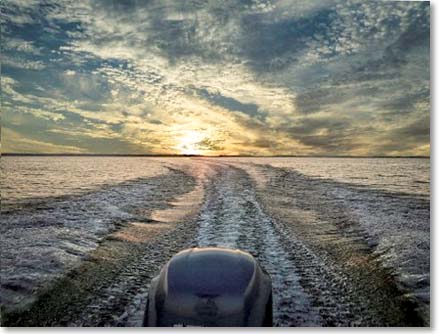
|
| After fishing on my home lake Hubbard outside of Dallas, I was heading home when I looked behind me to discover this remarkable wake leading into that complex sky matrix. Always check what's behind you. |

|
| SUNRISE AT DEEP WATER CAY was striking from any angle, but letting the opening in the clouds frame the structure at the end of the pier made it irresistible. |
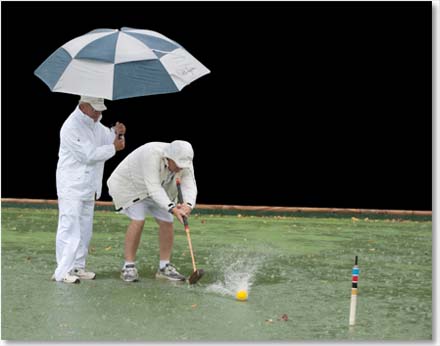
|
| This shot of players determined to continue play on a flooded court appeared in my book "Serious Croquet." Most of the images in the book were Photoshopped with black backgrounds to add emphasis to the most important visual elements. This shot, taken at the Dallas Classic tournament, had all the elements (pun intended) of the difficult conditions we sometimes have to endure during tournament play. When composing the image, the empathy of the non-playing viewer was paramount in my mind. |
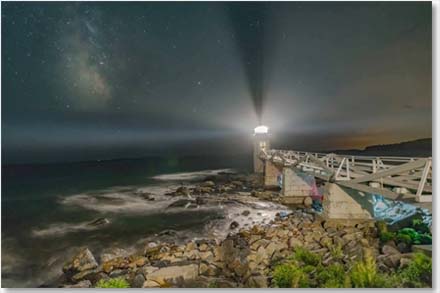
|
| This image of the lighthouse at Warren, Maine is iconic for the portrayal of kinds of light: The artificial light and the Milky Way are both captured in the same shot. You will notice the black spoke of the light that actually made the shot possible. If I had positioned myself two feet on either side, the light itself would have obliterated the image. A long exposure time of 15 seconds made the exposure possible. |
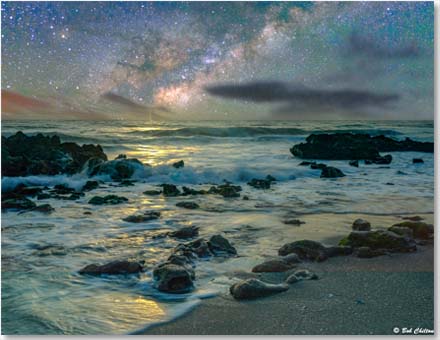
|
| This composition is very complex and took a long time to complete. It consists of two images taken several months apart in two completely different parts of the country. The Milky Way was shot in Moab, Utah and the Jupiter Rocks in Florida. They were then blended in the computer to give the illusion of the stars reflecting on the waters at night--although I actually photographed the rocks in broad daylight. |
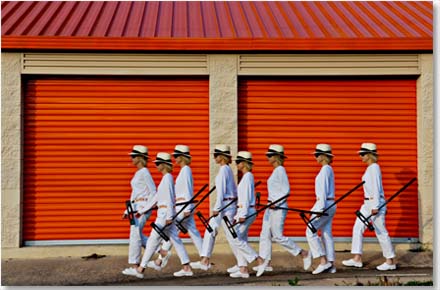
|
| In this treament I wanted the viewer to imagine the crowd going to play our favorite game. With Photoshop I was able to use a bit of the artist's prerogative by showing the same subject in motion in a series of positions. The background of a temporary storage facility gave a nice contrast to our traditional uniforms. |
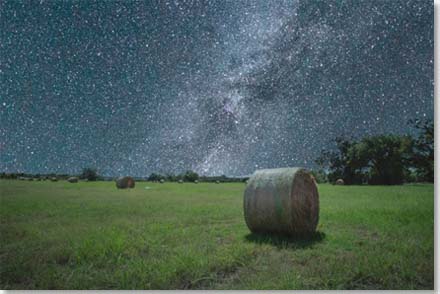
|
| The photographer Diane Arbus said, "A photograph is a secret about a secret. The more it tells, the less you know." A photograph can be regarded as a question within a question. To answer one of your questions: this blended image is a composite of a pasture in Texas and the Milky Way I photographed from Moab, Utah. I liked the reflections from the top of the bales and thought they would be a superb compliment to the dramatic sweep of the star light. |
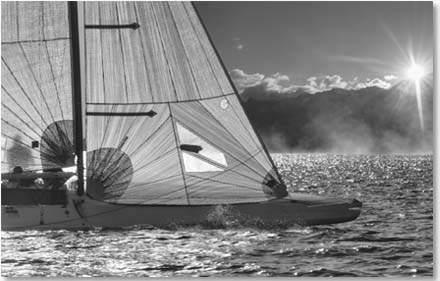
|
| This sailboat is an A class scow competing on an inland lake in Texas. The back lighting dramatizes the geometry of the Mylar jib--seen more clearly in black and white than in color. |
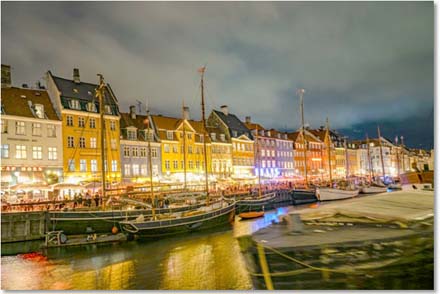
|
| Copenhagen's revitalized canal system has been much photographed in the daytime. In showing this magnificently lighted row of colorful old-world houses, I wanted to convey the vitality of its nightlife. Nighttime can bring out a stunning vibrancy of colors if you induce a sufficient amount of light with long exposure and editing. |
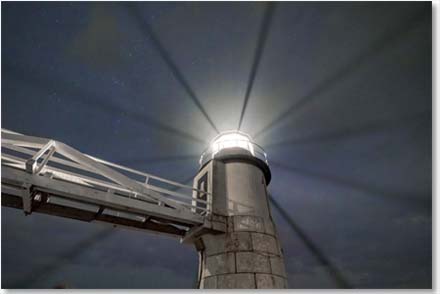
|
| Lighthouses can make spectacular subjects if you take special care to magnify light and dark contrasts. The "spokes" here are actually shadows created by joints of the glass panes in the top of the light house. Standing below the direct beam was the key to getting just the right shot--just before the tide rose too rapidly! |

|
| In this portrait of the late Archie Peck, I wanted to convey how we saw him day in and day out at the National Croquet Center--in his cart, checking out the players and the lawns. His ever-present smile as well as his pose had to be there, of course. Shooting him inside the cart created some lighting problems, so I used a strobe in a “soft box” in order to give the shot some illumination, but not so much that it would become harsh. |
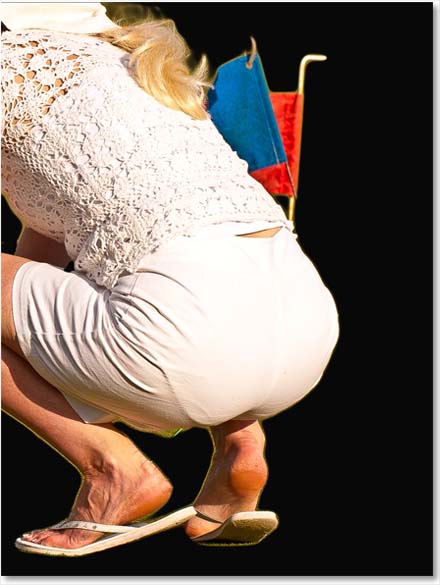
|
| There is a lighter side of our serious game. Can you identify the person from this partial viewing? |
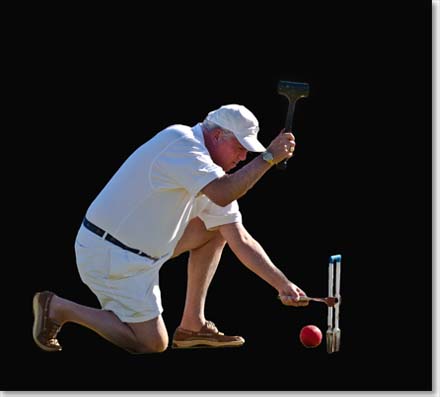
|
| Pounding wickets--and doing it precisely and well--is one of those behind-the-scenes duties that is vital to managing a well-produced tournament but seldom photographed. Stewart Jackson took on the job as referee for a major event at the National Croquet Center. |
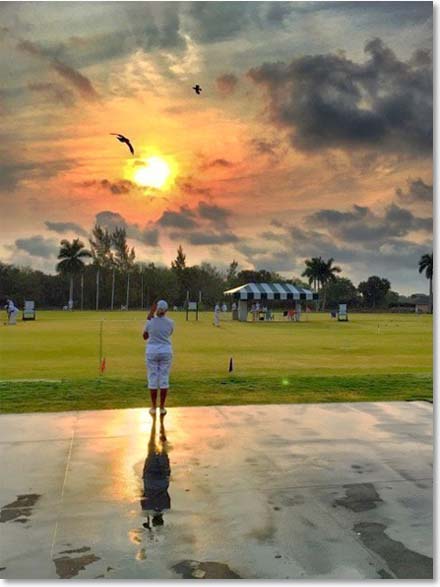
|
| I happened to arrive early for tournament play at the National Croquet Center just after the sprinklers had finished a cycle, leaving a wonderful reflective surface on the concrete entrance to the courts. So I asked one of the players to pause and hold still for a moment so I could capture an image balancing all those effects of light and shadow and reflection. After editing I realized it was a winner, so I emailed it to the USCA's CROQUET NEWS quarterly, and the next time I saw it was on the cover. |
AND MORE TO COME:
See the blog at BobChilton.com for more information on the release of his instructional art photography video: Artistic Cell Phone Photography. In process is a book of images of the darker side of the day entitled "The Lightness of Darkness."